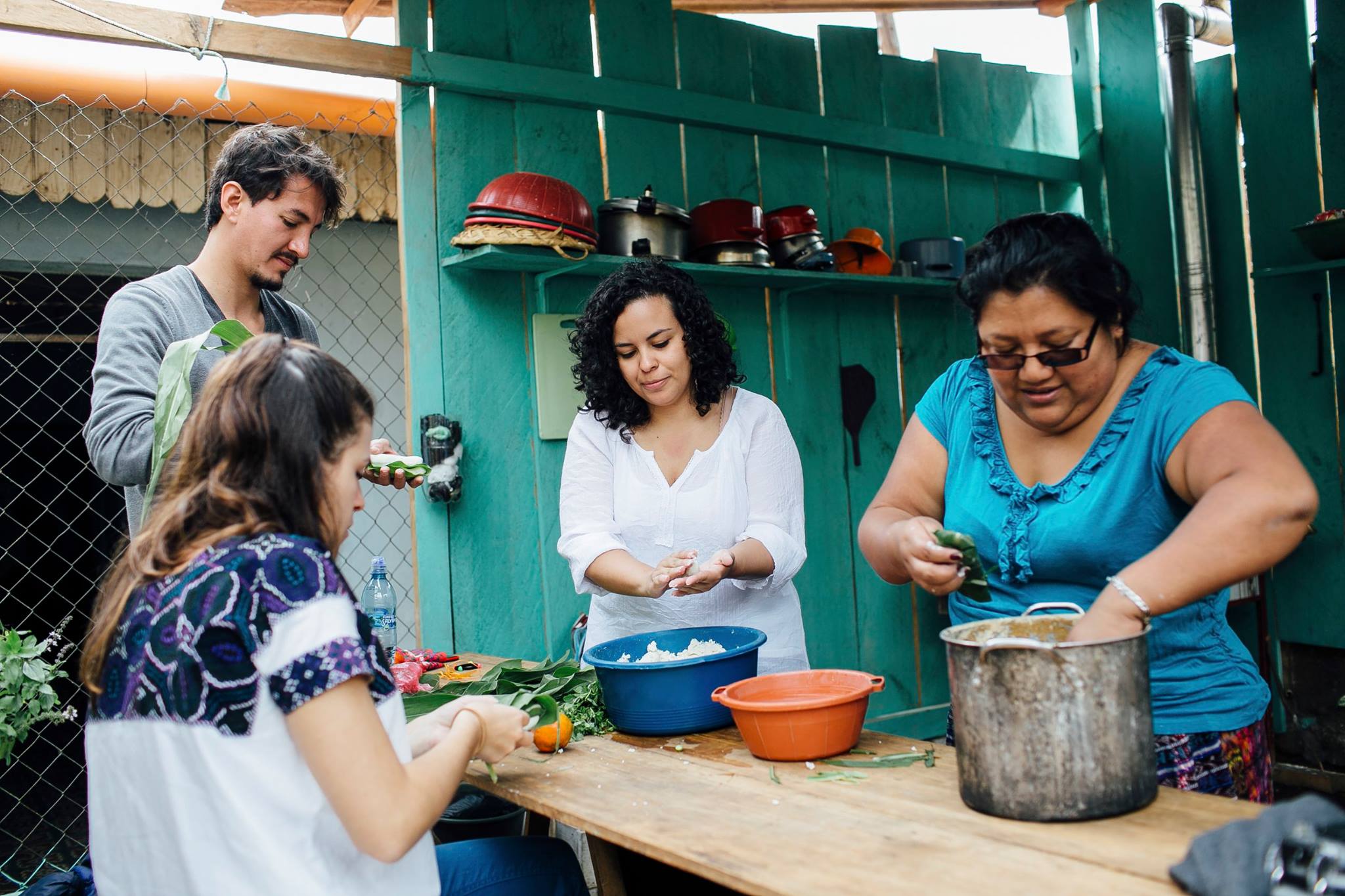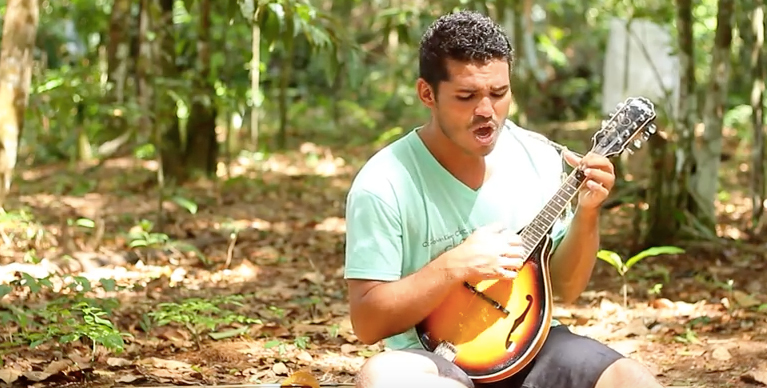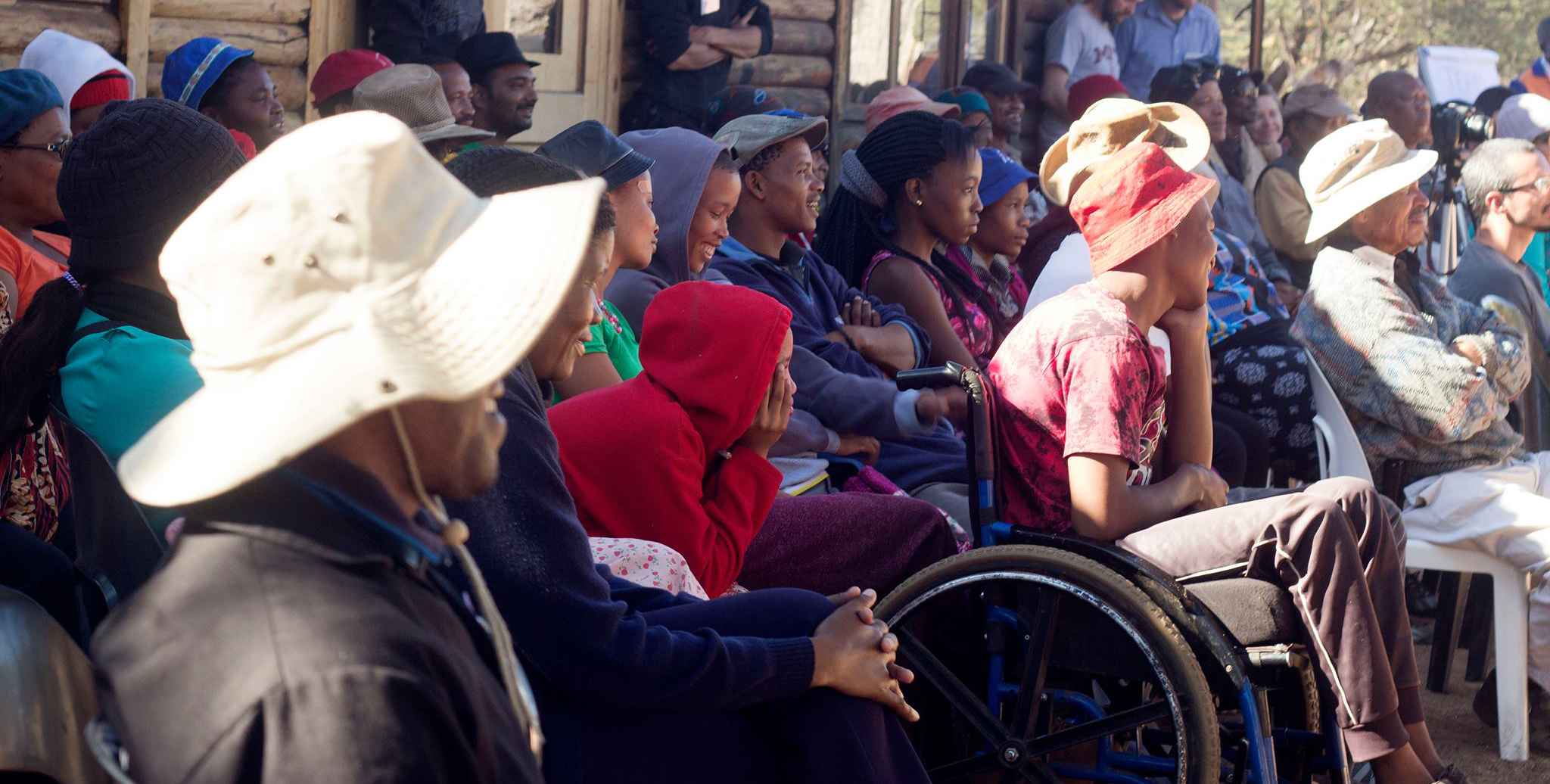Sustainable Homes, Sustainable Partnerships: Building a Design for Development Ecosystem in Guatemala

Helping Elmy prepare a traditional dish in Sololá. Photo by Ana Aguilar.
Nestled in the northern Guatemala highlands, Lake Atitlán has been called one of the most beautiful lakes in the world, drawing scores of tourists to Guatemala each year. But modern practices and population growth are affecting both the lake and its local communities in a myriad of ways.
The lake is a source of water, food, and income to local communities, but it is being contaminated at an alarming rate – trash, human waste, and fertilizer run-off put the lake’s many resources at jeopardy.
When IDIN Network members and Guatemalan natives Omar Crespo Cardona and Oscar Quan Lainfiesta began working with local communities in rural Guatemala a few years ago, one thing was clear: no one technology was going to solve the problems these families were grappling with. Complex challenges called for more holistic solutions.
One of Omar and Oscar’s first projects was trying to introduce more efficient cookstoves. Traditional cookstoves are not only bad for the environment, but also detrimental to family health, particularly for women and children who spend more time in the home.
“We realized to introduce this technology, you have to think not just about the technology, but everything related to it. Fuels, forests, and homes,” Omar explains. “In the highlands, a traditional cookstove is not just for preparing food. It heats the home in a region where it is very cold and other kinds of heating systems are hard to come by, so families are resistant to adopting these more efficient cookstoves that produce less heat.”
More than half of Guatemala’s population lives in a rural area, and those rural communities account for more than 70 percent of the Nation’s population that lives in poverty.
“We started with cookstoves, but uncovered so many other needs in our early work,” Oscar says. “So we had to think bigger, and that’s where the ‘sustainable homes’ theme comes from. We’re looking at the basic needs of these households, and how those needs are connected and can be addressed through a whole system of approaches and technologies."

Photo by Omar Crespo Cardona.
For Omar and Oscar, “thinking bigger” has manifested itself in several different ways.
The duo, who met when they were asked to teach a course together at Universidad Rafael Landivar, have since co-founded Guatemala’s Link4: Association for Innovation and Sustainable Development, a social impact agency dedicated to working with communities to address development challenges. They started their own design for development courses for design and engineering students at local universities including their alma mater. In 2017, they will bring the first-ever International Development Design Summit to Guatemala, and they have even bigger plans for the future.
Bringing Design for Development into (and out of) the Classroom
“These students have incredible potential as engineers, but their purpose is defined by the technology itself, not the use it can be put to to make a difference,” Victor Ayerdi, Director of Mechanical Engineering at Universidad del Valle de Guatemala would say to Omar and Oscar as they planned a new course on design for development. The new course would connect students more meaningfully with the communities in need, incorporating principles not typically associated with the field of engineering, such as empathy and deep listening.
Taught at Universidad del Valle de Guatemala, Omar and Oscar’s “Design and Innovation for Development” course is multi-disciplinary, aimed at students from diverse backgrounds while their “Design for Sustainability” course at Universidad Rafael Landívar is aimed at industrial design students.

Omar Cardona Crespo conducting a design training. Photo by Paul Crespo.
The curriculum for both courses draws upon a number of methodologies and approaches, including D-Lab’s Creative Capacity Building approach, IDIN’s International Development Design Summit curriculum, human-centered design, social innovation principles, project-based learning and more.
Omar and Oscar didn’t have to start from scratch. Other IDIN Network members had begun adapting this methodology to fit their needs too. In 2014, Omar teamed up with Miguel Chaves, Mariana Negrao, and Julio Lavalle, all IDIN Network members in Brazil, to adapt the International Development Design Summit curriculum for a new social innovation course to be taught in high schools near and around Sao Paulo. Omar fondly recalls teaching design lessons over a Skype connection to students in the early iterations of the class.
Once Omar and Oscar had pulled together the core components of the class, they began to fill in the details – design activities, contextualized content about development challenges specific to Guatemala, and more. They also reached out to local experts on design and development to involve them in the class as judges for design reviews and project mentors.
Omar and Oscar also work to connect their students with IDIN and D-Lab innovators outside of Guatemala. D-Lab Research Technical Specialist Gwyn Jones has been a mentor for a design team, and connected a team to Bikes Not Bombs, an organization that was working on a similar project with IDIN Network member Carlos Marroquin. Last year, D-Lab: Energy Instructor Amit Gandhi and D-Lab Research Scientist Dan Sweeney were judges for a design review session with six teams working in cooking systems. And IDIN Network member Mona Mijthab gave a virtual talk to students at Universidad del Valle de Guatemala on her inspiring journey designing and developing the MoSan toilet and sanitation system.
“All of these resources are of huge interest to our students and directors of course, as they provide tons of expert views, diversity and inspiration to all of us,” Omar says.
One challenge in building the course was finding a way to incorporate an experience for the students to interact in a meaningful way with the community without taking them out of their regular routines.
“It’s important for them to explore and listen to the communities,” Omar explains. “To understand what problems and needs they have and get in touch with the users, and not just receive an assigned project from there and start in the field.”
For some projects, Omar and Oscar organize a community meeting where the students meet local community members through a storytelling session, usually combined with a hands-on design activity called a “skillbuilder.”
To date, Omar and Oscar estimate that their design for development courses have reached 205 students in local universities, and they are looking forward to next year.

Design students Stefanie and Loren building a cornsheller during a workshop in the community of Huité. Photo by Omar Crespo Cardona.
Problem-Solving with Local Communities
Last year, Omar and Oscar decided they wanted to organize their own International Development Design Summit (IDDS) in Guatemala. Omar had participated in several of the design summits before, including the very first at MIT back in 2007, and Oscar had recently returned from Arusha, Tanzania where he attended IDDS 2014.
“I had been doing design and development work for a while, but IDDS was confirmation for me that it was possible to work on this full-time,” Oscar explains. “It was good to get to know innovators from other countries, and to build connections with them. After that, our talks to organize a design summit of our own got more serious.”
IDDS Hogares Sostenibles, or Sustainable Homes, will be held in June 2017 and will bring together 48 participants from both Guatemala and other countries to learn how to co-create appropriate technologies, services, and implementation strategies to transform conventional houses into sustainable homes.

Design students and instructors plan a design training. Photo by Omar Crespo Cardona.
The summit is organized by Link 4: Association for Innovation and Sustainable Development and Universidad del Valle de Guatemala with support from the IDIN Network. Eight community-based projects will be identified as vehicles for learning about the co-creative design process and about the complementary systems within a home. These projects will explore interconnected themes: energy, sanitation, water, cooking systems, and waste management.
To prepare for the summit, Omar and Oscar are conducting a number of Creative Capacity Building trainings near Lake Atitlán. These 3-5 day hands-on skills-building workshops introduce the design process to community members, regardless of their educational background. The workshops will also help better identify challenges to be addressed during IDDS Hogares Sostenibles.
Omar and Oscar see IDDS as a catalyst for the innovation ecosystem they are building in Guatemala. They hope to recruit a diverse group of organizers and participants so that local community members, students, professionals, and social innovators can work beside private sector decision makers on solutions that matter.
“We hope that it will mobilize actors and start collaborations that grow at IDDS and beyond,” Omar says. “We are getting all of these actors together and redirecting them on the same path.”
Different Partners Marching to the Same Beat
Omar and Oscar’s long-term vision is to build an innovation ecosystem in Guatemala that can work side-by-side with communities over time.
“We don’t want to be in and out, starting isolated projects, but instead we have a long-term vision to move local actors in one direction to make more impact,” Omar explains. “We want to help channel these actors to connect with the community’s needs and problems.”
Oscar adds, “There’s a lot of (corporate social responsibility) money being used not in the best way, and we want to get these actors to open their eyes to other possibilities to spend that way. Actually thinking about shared values with communities, and projects that make sense and have sustainable built in from the beginning.”
They share a hypothetical: instead of a company coming in and donating large sums of money to build a house, could they instead donating the money to building a maker space so that the community could build many houses and other technologies in the process?
Omar and Oscar’s long-term strategy sees the design summit, classes, and community projects all involving stakeholders from academics, the social sector, and the private sector working in concert with one another. They hope to work with local partners to open an innovation center in Sololá which can serve a hub of year-round innovation activity, with trainings, courses, project incubation, and more.
“We want to build networks instead of going in different directions,” Omar says. “We can achieve more if we combine forces and begin to build an innovation ecosystem.”






